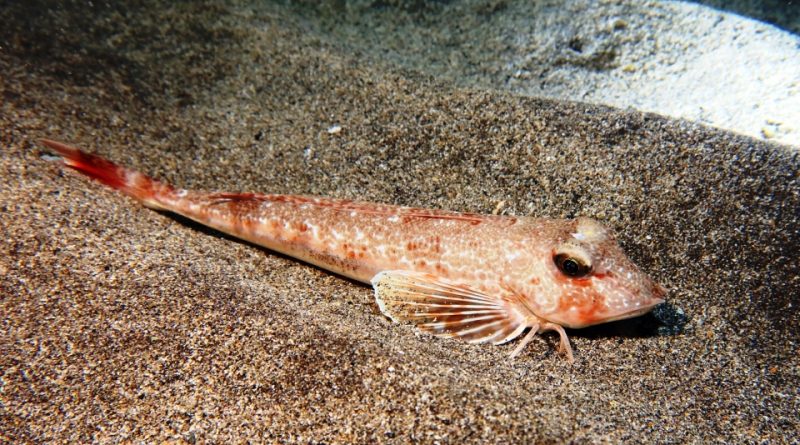Chelidonichthys obscurus
Chelidonichthys obscurus
The longfin gurnard or long-finned gurnard, shining gurnard (Chelidonichthys obscurus Bloch & Schneider 1801) is a sea fish belonging to the Triglidae family.
Systematic –
From a systematic point of view it belongs to:
Eukaryota domain,
Kingdom Animalia,
Subkingdom Eumetazoa,
Phylum Chordata,
Subphylum Vertebrata,
Superclass Gnathostomata,
Class Actinopterygii,
Infraclass Teleostei,
Order Scorpaeniformes,
Suborder Scorpaenoidea,
Triglidae family,
Genus Chelidonichthys,
Species C. obscurus.
The term is basionym:
– Trigla obscura Walbaum, 1792.
The terms are synonymous:
– Aspitrigla obscura (Bloch & Schneider, 1801);
– Aspitrigla obscura (Linnaeus, 1764);
– Aspitrigla obscura (Walbaum, 1792);
– Chelidonichthys obscura (Bloch & Schneider, 1801);
– Trigla obscura Bloch & Schneider, 1801.
Geographic Distribution and Habitat –
The Chelidonichthys obscurus is a fish present in the Mediterranean Sea and the eastern Atlantic between the south of the British Isles and Senegal.
It is rare off southern England, and Ireland and its distribution extends from there south to Mauritania, including the Canary Islands, the Azores and Madeira. Although it is found in most of the Mediterranean, it is very rare off the coast of Turkey and is absent in the easternmost part of this sea. It is also uncommon on the Italian coasts, more present in the Tyrrhenian Sea.
Its marine habitat, being a demersal and benthic fish, is that of the continental shelf where it lives on soft substrates and among collapsed rocks. It is found at depths between 20 and 170 m (66 and 558 ft). It lives in seabeds even close to the coast (up to 20 m).
Description –
The Chelidonichthys obscurus is a fish that has ray fins with a large head armored by large bony plates characterized by numerous crests and spines, without an occipital sulcus.
It has a slender and elongated body, tapering towards the tail, slightly compressed laterally, with skin covered with small cycloid scales.
The upper body is reddish pink, the flanks are iridescent and the lower body is pale, with a maximum published total length of 50.5 cm but normally not exceeding 30 cm.
The mouth opens downwards and is almost horizontal. The teeth are villiform and are found only on the maxillae and vomer.
It has two separate dorsal fins, the first contains 10 or 11 spines while the second has between 17 and 19 soft rays and the anal fin has 17 or 18 soft rays. The first spine of the dorsal fin is elongated and there are three pectoral fin rays separated from the fin. The scales on the lateral line are plate-like.
The pectoral fins are dark blue and the other fins are yellowish.
Biology –
Chelidonichthys obscurus is a fish whose reproduction follows a typical cycle.
It reaches sexual maturity between two and four years of age, depending on the region.
The spawning season can vary by region, but typically occurs in the spring and early summer, when water temperatures rise and there are more food resources available.
During courtship, males display territorial and competitive behaviors to attract females. Once a pair has formed, the female will deposit her eggs in a protected area, such as sandy or rocky bottoms.
The eggs are fertilized externally by the males, who release their sperm on top of the eggs as the female lays them.
The eggs are left alone to develop. The length of the incubation period depends on the water temperature and can vary from a few days to several weeks.
The larvae hatch from the eggs, which then become part of the marine plankton for a variable period of time, during which they feed on small organisms.
After a period of growth and development, the young specimens reach sexual maturity and the reproductive cycle can begin again.
Ecological Role –
Chelidonichthys obscurus was first formally described in 1798 as Trigla obscura by the German physician, naturalist, and taxonomist Johann Julius Walbaum, with the type locality given as the Mediterranean Sea. The specific name obscura means “dark”, “dim” or “indistinct”, Walbaum did not explain but may refer to the simple color pattern of this species compared to C. lastoviza.
This fish feeds mainly on benthic invertebrates, especially mysids, crustaceans and lamellibranchs.
Unlike other Triglidae, it burrows into the sand when it feels threatened.
It is caught with trammel nets and bottom lines and its meat is appreciated for fish soup.
This fish is not commercially exploited in the Atlantic area, although it can be caught and eaten as bycatch. However, in the Mediterranean, it is of less commercial interest. It is regularly present in the fish markets of Spain, Morocco, Italy, Cyprus and Egypt, and sometimes in France, Greece and Turkey, although they are rarely marketed in Tunisia. The catch is sold fresh, chilled and frozen.
Guido Bissanti
Sources
– Wikipedia, the free encyclopedia.
– GBIF, the Global Biodiversity Information Facility.
– Louisy P., 2016. Guide to the identification of marine fishes of Europe and the Mediterranean. Il Castello Editore, Milan.
– Nikiforos G., 2008. Fauna of the Mediterranean. Giunti Editore, Florence.
Photo source:
– https://inaturalist-open-data.s3.amazonaws.com/photos/144740466/original.jpg
– http://photos.gbif.fr/mnhn_nice/aquarelles_animaux_marins_et_plantes/2005-0-860.jpg


